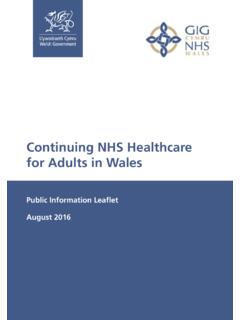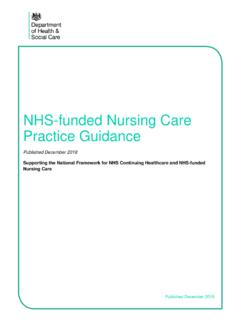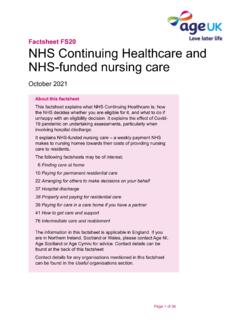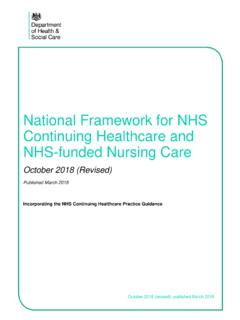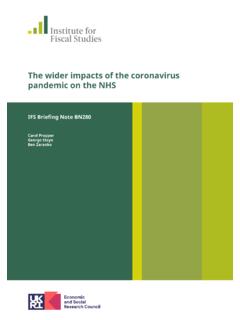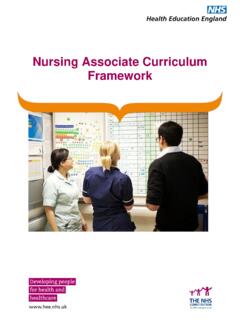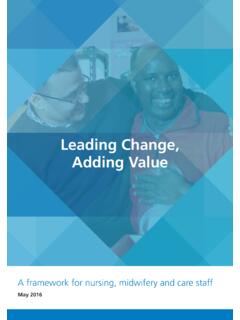Transcription of 12 Prevalence, views and impact - NHS England
1 12 hour shifts: Prevalence, views and impact Report to Dr Ruth May, National Lead Compassion in Practice: Action Area 5 Jane Ball Jill Maben Trevor Murrells Tina Day National nursing Research Unit, King s College London Peter Griffiths University of Southampton & NIHR Collaboration for Applied Health Research & care June 2015 Acknowledgements We would like to thank all those who contributed to the study, with particular thanks to Ruth May and Pauline Milne for supporting this work.
2 Our thanks to Josie Irwin, Director of Employment Relations, Royal College of nursing , for allowing us to undertake secondary analysis of the RCN commissioned Employment Surveys, and to Geoff Pike of Employment Research for his assistance in collating the data sets. We also acknowledge the support of RN4 Cast Consortium, led internationally by Linda Aiken and Walter Sermeus, and thank the co-principal investigator in England , Anne Marie Rafferty for her support. Many thanks to Chiara Dall Ora for sharing her early analysis of RN4 Cast EU data on 12-hour shifts with the project team and contributing to the analytical framework deployed.
3 This is an independent report by the National nursing Research Unit (NNRU) at the Florence Nightingale Faculty of nursing and Midwifery, King s College London in collaboration with the University of Southampton. The NNRU received funding from NHS England to support this work. The views expressed here are those of the authors, not necessarily those of NHS England . This report should be cited as: Ball J, Maben J, Murrells T, Day T, Griffiths P (2014) 12-hour shifts: prevalence, views and impact . National nursing Research Unit, King s College London. NHS England Publications Gateway Reference: 03620 Contact address for further information: National nursing Research Unit Florence Nightingale Faculty of nursing and Midwifery King s College London James Clerk Maxwell Building 57 Waterloo Road London SE1 8WA Email: NNRU website: Florence Nightingale Faculty of nursing and Midwifery website: Contents 1.
4 Introduction and background .. 5 Introduction .. 5 Background .. 5 Aim .. 6 Approach .. 6 2. Review of literature .. 8 Approach .. 8 Results .. 10 Nurse outcome studies .. 12 Patient outcome studies .. 16 Summary .. 20 3. Profile of nursing shift patterns in the UK: RCN surveys .. 22 RCN employment survey data .. 22 Overview of nurses working patterns .. 23 Change in 12-hour shift working between 2005 and 2009 .. 25 Nurses views of their working hours by shift length .. 27 Summary .. 28 4. impact of 12-hour shifts: RN4 Cast survey analysis .. 29 Length of shifts worked by RNs on acute NHS wards .. 29 Analysis using staff and patient outcome indicators.
5 31 Results by outcome .. 31 Summary .. 34 5. Conclusion .. 35 Appendices .. 39 5 1. Introduction and background Introduction One of the action areas in the NHS England s Compassion in practice nursing , midwifery and care staff our vision and strategy is action area five: ensuring we have the right staff, with the right skills in the right place.
6 Dr Ruth May (Regional Chief Nurse, Midlands and East of England ) is the senior responsible officer leading this work nationally. On behalf of Dr Ruth May, Pauline Milne (Head of Clinical Workforce Development and Planning, Health Education East of England ) invited the National nursing Research Unit (NNRU) of King s College London to undertake research into 12-hour shifts, using existing data sets and published evidence to explore the prevalence, views and potential impact of 12-hour shifts. Background The provision of 24-hour nursing care inevitably involves shift work and flexible working, including long days or 12-hour shifts (Newey and Hood 2004, Lorenz 2008).
7 However, these shift patterns have become increasingly controversial, with concerns raised over performance, fatigue, stress and patient safety. Historically, traditional shift work patterns were based on three eight-hour shifts per day (Ferguson and Dawson 2011, Estabrooks et al. 2009), but over the past 20 years there has been a tendency to move away from this pattern of working in preference for the 12-hour shift (Todd et al. 1989, McGettrick and O Neill 2006). In the UK, many hospitals utilise 12-hour shifts primarily because managers believe it is a more cost effective way of providing 24-hour care , with lower costs and greater continuity of staffing (Estabrooks et al.)
8 2009). Some nurses also prefer to work longer daily hours with fewer shifts, which gives them greater flexibility and more days away from work (Josten et al. 2003). As the majority of the nursing workforce is female, this may also make it easier to balance work and personal responsibilities (Messing 1997, Josten et al. 2003). However, there are increasing concerns over potential threats to patient safety and quality of care (Stimpfel and Aiken 2013), and some employers now question the benefits of such extended hours and are choosing to revert to eight-hour shifts (Geiger-Brown and Trinkoff 2010). Although the handover period has been criticised for being unproductive, with no formal overlap 12-hour shifts can have a negative impact on opportunities for ward meetings, teaching, mentorship, teambuilding and research (Sprinks 2012).
9 A study in the US by Stimpfel and colleagues published in 2013 found that nurses who worked shifts of 12-hours or longer were significantly more likely to report poor quality care and poor patient safety when compared to those working eight-hour shifts. Patients also reported lower satisfaction with care in hospitals where staff worked longer shifts (Stimpfel et al. 2012). 6 Shift work is a common feature across many industries. Fatigue associated with long shifts has been linked with disasters such as the Chernobyl nuclear accident, Three Mile Island incident and the grounding of the Exxon Valdez (Miller 2011).
10 However, research to date is equivocal and some studies have found little differences in terms of cost or productivity (Williamson et al. 1994) or levels of fatigue (Duchon et al. 1994) by shift length. A systematic review by Smith et al. (1998) compared eight and 12-hour shifts across a broad range of industries and concluded that longer shifts increased fatigue but also led to an increase in job performance. Tucker et al. (1998) examined the effect of shift length on alertness. Their findings showed that more rest days between shifts were associated with slightly higher levels of alertness and lower levels of fatigue. In nursing , Geiger-Brown and Trinkoff (2010) reviewed studies up until 2008.










